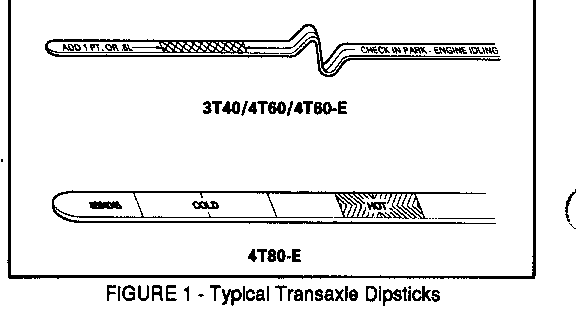INFO. ON AUTOMATIC TRANS. FLUID LEVEL CHECKING PROCEDURE

SUBJECT: INFORMATION ON AUTOMATIC TRANSAXLE FLUID LEVEL CHECKING PROCEDURE
VEHICLES AFFECTED: 1990-93 "A,C,E,H,J,K,L,NV,W" MODELS AND "U" VAN
TRANSMISSION APPLICATIONS:
1990-93 HYDRA-MATIC 3T40 (RPO MD9) 1990-93 HYDRA-MATIC 4T60 (RPO ME9) 1991-93 HYDRA-MATIC 4T60-E (RPO M13) 1993 HYDRA-MATIC 4T80-E (RPO MH1)
BULLETIN COVERS:
Transaxle fluid level checking and condition information. This updates all information previously published for 1990-93 HYDRA-MATIC 3T40, 4T60, 4T60-E and 4T80-E transaxles.
Due to enhancement of assembly plant fluid fill capabilities, it is especially important to warm the transaxle up to operating temperature before determining that fluid needs to be added. If the transaxle fluid is close to operating temperature, the fluid level may read slightly below the "ADD" mark. DO NOT ADD FLUID UNLESS THE TRANSAXLE IS AT OPERATING TEMPERATURE AND THE DIPSTICK SHOWS FLUID LEVEL IS BELOW THE CROSSHATCHED AREA.
TRANSAXLE FLUID LEVEL INFORMATION:
Checking fluid level and condition (colour and smell) at recommended service intervals will provide early diagnosis information about the transaxle. This information may then be used to correct a condition that, if not detected early, could result in major transaxle repairs.
When adding or changing fluid, use only DEXRON(R)-IIE. Refer to Maintenance and Lubrication (Service Manual Section OB) for maintenance information and service intervals.
NOTICE: Do not overfill. Overfilling will cause foaming, loss of fluid, shift complaints and possible damage to the transaxle.
Fluid level should only be checked when it reaches a normal operating temperature of 82-93 degrees Celsius (180-200 degrees Fahrenheit). This temperature is reached after approximately 24 km (15 miles) of driving.
TRANSAXLE FLUID COLOUR:
Fluid colour will be red when new.
IMPORTANT: When new, automatic transaxle fluid is red in colour. The red dye is added so the assembly plant can identify it as transaxle fluid and distinguish it from engine oil or antifreeze. The red dye is not an indicator of fluid quality and is not permanent. As the vehicle is driven the fluid will begin to look darker in colour. The colour may eventually appear light brown. A dark brown colour with a burnt odor may indicate fluid deterioration and signal a need for a transaxle fluid change.
TRANSAXLE FLUID CHECKING PROCEDURE:
1. Start engine and drive vehicle until the transaxle reaches operating temperature of 82-93 degrees Celsius (180- 200 degrees Fahrenheit). This temperature is reached after about 24 km (15 miles) of driving.
Inaccurate fluid level readings will result if the fluid level is checked immediately after the vehicle has been operated under certain conditions:
o When outside temperatures are above 32 degrees Celsius (90 degrees Fahrenheit)
o At sustained high speeds
o In heavy city traffic during hot weather
o Towing a trailer
o In commercial service such as taxi or police use
If the vehicle has been operated under any of these conditions, shut the engine off and allow the vehicle to cool for thirty (30) minutes. Then restart the vehicle and continue with step two.
2. Stop vehicle on level ground and put the gear selector in "P" (Park).
3. Set parking brake.
4. With your foot on the brake pedal, move the shift lever through each gear range, pausing for about three seconds in each range. Then put the gear selector, back in "P" (Park).
5. Let the engine idle for three to five minutes.
6. Pull out the dipstick and wipe it with a clean rag or towel.
7. Push it back in all the way, wait three seconds and pull it back out.
8. Check both sides of the dipstick and read the lower level. The fluid should be in the crosshatched "HOT" area.
IMPORTANT: The fluid level is OK if it is anywhere within the crosshatched area. It does not have to be at the top of the crosshatched area. Do not add fluid unless the fluid level is below the crosshatched area.
9. If the fluid level is where it should be, push the dipstick back in all the way.
ADDING TRANSAXLE FLUID:
If fluid level is low (after properly performing the checking procedure above) add only enough fluid to bring the level into the crosshatched area. It doesn't take much fluid, generally less than a pint. Don't overfill. Remember that the level does not need to be at the top of the crosshatched area to be correct.
After adding fluid, always recheck the fluid level as described in the above procedure.

General Motors bulletins are intended for use by professional technicians, not a "do-it-yourselfer". They are written to inform those technicians of conditions that may occur on some vehicles, or to provide information that could assist in the proper service of a vehicle. Properly trained technicians have the equipment, tools, safety instructions and know-how to do a job properly and safely. If a condition is described, do not assume that the bulletin applies to your vehicle, or that your vehicle will have that condition. See a General Motors dealer servicing your brand of General Motors vehicle for information on whether your vehicle may benefit from the information.
